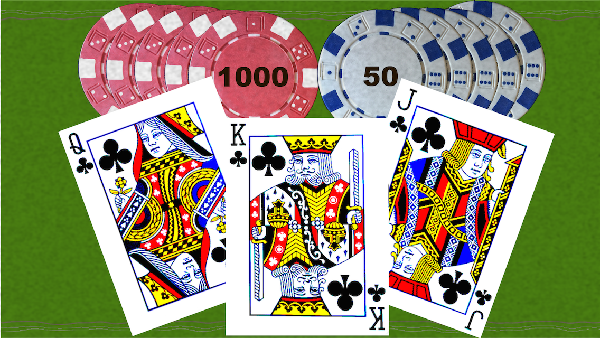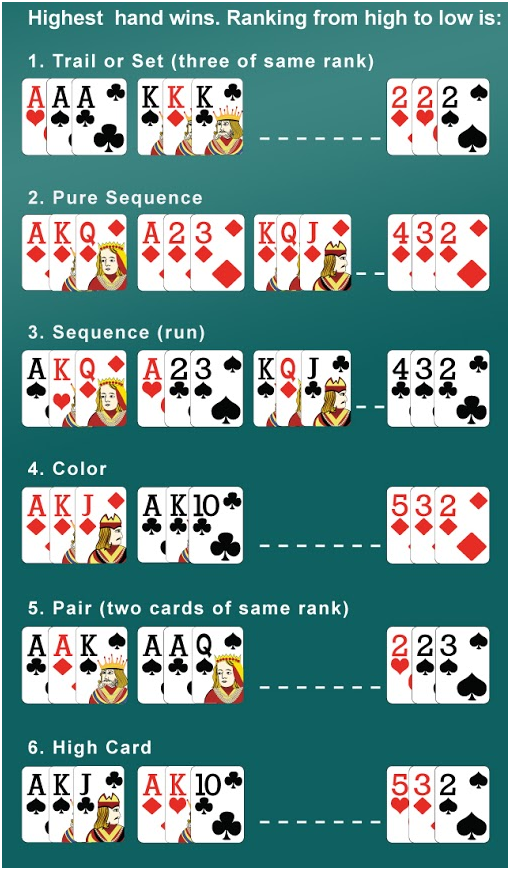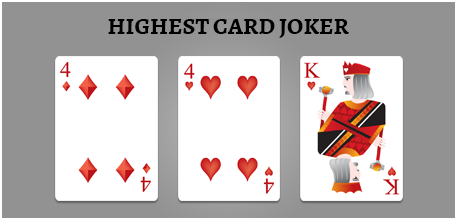Teen Patti

Teen Patti is an Indian card game played in a group of three to six persons with 52 cards without jokers. As the name suggests Teen means three and Patti means cards, each player is dealt with three cards face down.
When playing with real money or betting or gambling whatever you may call, before the cards are dealt the money is decided among players and collected from each member of the game. This amount is the minimum stake that is then put in the pot and kept in the centre of the table. As the game progresses the pot money grows and is won by the winner of that hand.
Card rankings from high to low
As now you understands that winner is the player who remains in the game till the completion of the hand and has the best hand or the highest hand based on the cards ranking
- Trail or Set (three of same rank),
2. Pure sequence,
3. Sequence (or run),
4. Color,
5. Pair (two cards of same rank), and
6. High Card.
The figure below shows highest to lowest cards of each rank. It should be noted that in a sequence A-K-Q is the highest ranked sequence while A-2-3 is the second highest ranked sequence.

How to play Teen Patti
The game starts with one of the players dealing the cards. The cards are usually dealt counter-clockwise.
Before starting the game, usually an agreed number of card(s) are picked or dealt to decide the dealer for the opening hand. Each player may be required to put up an ante into the pot before picking or dealing the card(s). The winning player gets the pot. The relative rankings of the card(s) may also decide the seating arrangement for each player. This entire process is called cut-for-seat. After the first/opening hand, the winner of any hand will be the dealer for the next hand.
Betting in Teen Patti
Betting is usually an ante or boot amount put on the table (the pot). The betting then starts by the player next to the dealer.
Once the money is collected from each player the cards are dealt face down. Now it is the turn of the player next to the dealer in clockwise direction. The player has option to place a bet without seeing the cards or see the card. When the player sees his card, he can play chaal or may have other options depending upon the progress of the game. A player who places a blind bet is referred to as the blind player. A player who places his bet after seeing the cards is referred to as the seen player.
If as a blind player you are not allowed to see your cards. You have options to play Pack, Blind and Show if available. To play Blind put the bet amount in the pot. The Blind bet amount is equal to the current stake amount or twice the current stake amount. The current stake amount, in case of the first player, is the boot amount. Thus if the first player is a blind player, the player must bet amount equal to the boot amount or twice the boot amount.
The bet placed by a blind player becomes the stake amount for the next player while half of the bet placed by a seen player becomes the stake amount for the next player. In case of the next blind players, the bet amount can be equal to the stake amount or twice the stake amount.
A blind player can ask for a Show only when there is one opponent remaining in the game. This is a blind show. After asking for show, the cards of both the players become visible and the winner gets the pot.
A seen player can play Chaal, Pack or may have other options. The other options that may be available to the seen player are Show and Side Show. Once you have seen your cards, to remain in the game, you must play chaal unless you select any other available option.
Understanding ‘Game Move’ Terms in Teen Patti
When playing Teen Patti you will come across various game terms which you need to understand.
Chaal
Chaal word is a Hindi term meaning to play. The total bet can be divided into two components – the call and the raise, both being usually called as Chaal. For chaal the player must put the bet amount in the pot. The bet amount for a seen player is equal to twice or four times the current stake amount. If the previous player is a blind player, the stake amount for next player is amount bet by the player. If the previous player is a seen player, the stake amount for next player is half the amount bet by the player.
Like suppose, one player bet an amount of 2 and second player raises it up to 4, now the first person would have to put additional 4 into the pot to make a call or would have an option to raise the bet up to 8.
Side Show
Side Show means that you wish to compare your cards with the cards of the previous player. You can do this only if the previous player is also a seen player and there are one or more other players still in the game. For Side Show you put amount equal to twice the current stake in the pot. Your request for the Side Show is conveyed to the previous player. The previous player has option to accept or deny your Side Show request.
If your Side Show request is accepted and the previous player has better cards than you, you must pack. If your cards are better than the previous player, the previous player must pack. After one of you have packed, the turn passes on to the next player.
If your Side Show request is denied, you do not see each other’s cards and both of you remain in the game and the turn passes on to the next player.
Blind play
When you play blind, you have not seen your cards and place your bet by guessing the strength of your card combination and of other players. Place a higher bet if you have faith in your luck and your card combination will be stronger than other players. If you want to play it safe and not take risks, place bet for a smaller amount.
Tie
At any point during the game, if both players are not want to show/Back out his card then game will be consider as a cancelled and total money which is invested in the game that will be return/share between both players. There have not any situation to win the game by any player.
Teen Patti Game Variations
The benefit of playing teen patti is that one can create any form one likes; a combination of variations may be played simultaneously. Here are some of the interesting variations of the game.
Deuce-to-five-high
This is the most popular variation version. In this version, 2-3-5 (flash) is the highest straight (flash), even higher than the A-2-3 (flash). This variation makes sense as the odds of a straight flash is then evened up with the trio.
Best-of-four
Each player is dealt four cards from which they must make the best possible three-card hand.
Incomplete
In this variation, players are dealt an incomplete set of cards and then required to complete the full set by imagining the missing card(s), so as to complete the full set of three cards:
- Two cards deal/one card imagine: Each player is dealt two cards and the third card is imagined.
- One card deal/two cards imagine: Each player is dealt one card, and the other two cards are imagined, thus making a Trio.
- One card deal/one card imagine: Each Player is dealt one card,second card is imagined and a common card is opened on the table which is everybody’s “third” card.
Lowball or Muflis

It is just like the normal game except a person with lowest rank cards is a winner. For example, you have K-2-3 while other person has K-K-9, then you are the winner.
Blackjack
Each player is dealt three cards. Picture cards (jacks, queens and kings) carry 10 points, aces carry 1 or 11 points, and all other cards carry points as per their face value. The total number of points are added up. As in the standard game of blackjack, 22 points and over go bust, while the player having the highest number of points, up to 21, wins the pot.
Wild/joker draw
The dealer pulls out one card at random after dealing and nominates all other cards of the same rank/strength/number as jokers (wild cards).
Low wild/joker
Each player’s lowest-ranking card (and all other cards of that same rank/strength/number) are jokers (wild cards) in that player’s hand only. If the two lowest cards are a pair then that pair is considered as two jokers.
High wild/joker

Each player’s highest-ranking card (and all other cards of that same rank/strength/number) are jokers (wild cards) in that player’s hand only. If the two highest cards are a pair then that pair is considered as two jokers.
Two-lowest wild/joker
Each player is dealt four cards and the two lowest cards taken together forms a virtual wild card in that player’s hand only. If the two lowest cards are a pair then that pair may be considered as a single joker. In this version, if the two middle rank cards are a pair, then the player does not have any joker.
Bust card draw
The dealer pulls out one card at random after dealing and nominates all other cards of the same rank/strength/number as bust cards. Any player holding any of the bust cards has to pack/fold.
Stud
In this variation, each player receives a mix of prearranged combination of face-down and face-up cards. The cards dealt face down to each individual player are called hole cards (which in poker gave rise to the common English expression “ace in the hole”, suggesting that one has something valuable that is not apparent to others). The cards dealt face-up are called street cards.
Different versions in this variation are:
Three-card stud: Each player is dealt two face-down cards and one face-up card.
Five-card stud: Each player is dealt two face-down cards and three face-up cards. Some versions of this game may require players to compulsorily select any one face-down cards and any two face-up cards to make a three-card hand.
Community
This is a variation of stud. Players are dealt an incomplete hand of face-down cards, and then a number of face-up community cards are dealt to the center of the table, each of which can be used by one or more of the players to make a three-card hand. This variant was inspired by Texas hold-’em poker.
Versions are:
Three-card community: Each player is dealt two face-down cards followed by one face-up community card.
Five=card community: Each player is dealt two face-down cards followed by three face-up community cards. Some versions of this game may require players to compulsorily select any one face-down cards and any two face-up cards to make a three-card hand.
Draw
A complete hand is dealt to each player and, usually before (or after, but not both) betting, players are allowed to change their hand by discarding unwanted cards and being dealt new ones. Players may have to “purchase”/”buy” the new cards by putting a prearranged amount into the pot for each new card. Another version of draw allows players up to three chances to buy and change their hand, one card at a time, in the first three rounds of betting.
High-low split
In traditional teen patti games, the player with the best traditional hand wins the whole pot. Mufliss/lowball variations award the pot to the lowest hand. High-low split games are those in which the pot is divided between the player with the best traditional hand (called the high hand) and the player with the low hand. In this variation, there could be multiple players remaining in play at “show,” unlike the traditional or mufliss/lowball where there are usually only two players left at show. There are no sideshows and players may opt out from betting by folding/packing. Usually there are three or four mutually agreed upon rounds of betting where no player opts out, before having the show. Also, there is a limit of six-to-ten rounds of betting at the end of which there is a compulsory show.
Kiss, miss, and bliss
Five cards are distributed to each player. In this version, a player can make three types of “virtual” wild/joker cards:
Kiss: A numerically sequential pair is considered a single virtual wild card; e.g., A,2 or 8,9 or J,Q – but K,A isn’t considered wild.
Miss: A pair missing the card that would form a sequence is considered a single virtual wild card; e.g., A,3 or 8,10 or J,K – but K,2 isn’t considered wild.
Bliss: A pair having two same-numbered cards (regardless of suit or colour) is considered a single virtual wild card; e.g., 8,8 or A,A.
A player can make any combination of the above three as a part of their game and consider it as virtual wild card, but a player can use each type of combination only once in a hand. For example, a player may end up having one individual card, a kiss, and a miss), while another might have an individual card plus a kiss and a bliss, but it would not be possible to use two kisses with an individual card.
Cobra
Each player is dealt a single card. All players put in a pre-determined amount into the pot. All players, without seeing, pick their card and place it on their forehead. This way, each player can see everyone else’s cards. No player can see their own card. This variation is usually played as the very last hand of the game.
Blind (kaana) king and jack
Each player is dealt three or four cards. In this variation, any king or jack who has a side profile and only one eye visible (e.g., the king of diamonds, the jack of spades) is considered a wild card or joker. This round generally begins when someone gets a trio, and is continued until some player has asked for a show to the player holding the applicable king or jack; that is, these cards remain wild until a show is called, at which point their value must be declared.
In one of the Octro Teen Patti variations you will also find 999 where cards that are closest to 999 win. The J, Q, K, and 10 card are treated as 0. Ace is 1. If you have a 4, 9 and Ace, your cards are 941. If you have 10, 9 and K, your cards are 900.
Faceoff variation has cards 10, J, Q, K and A. Each player of the table will get at least one faceoff card. The player with highest rank cards is the winner.
In King Little the small card is the joker. Also all the Kings are jokers. The player with highest rank cards is the winner.
When you play Teen Patti for the first time, you play on a limited stake table. On the first limited stake table that you play, the boot amount is 2, you can play maximum 4 blinds, the maximum Chaal that you can play is 256 and the Pot limit is 2048. When the Pot limit is reached, all players still in the game are forced to show their cards and the winner gets the Pot.
In the next level limited table, the the boot amount is 4, you can play maximum 4 blinds, the maximum Chaal that you can play is 512 and the Pot limit is 4096. Players who have played many hands and have many chips play on higher level tables.
Before playing Teen Patti card game you need know the legality to play the game. As in many countries it is not allowed to play as real money play. Teen Patti is also available to play with your Android and this game app is for fun and entertainment where you can play with virtual chips and enjoy the game. If you have an Apple device like iPhone and iPad then you can have this app from iTunes and play Octro Teen Patti variation and have fun. Last but not the least you can also play Teen Patti at real casinos in India.